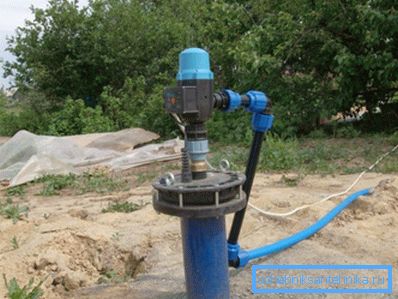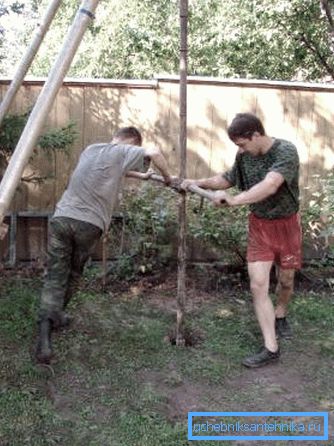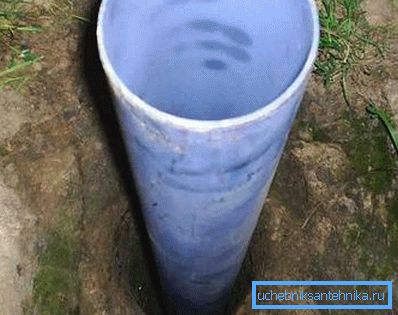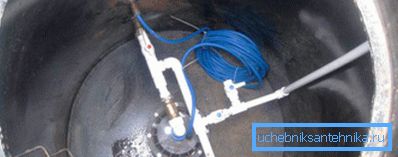Proper installation of the pump in the well - do it yourself
The question of the need for water on the land plot in recent years has not been considered, everyone understands that nothing alive can exist without life-giving moisture. That is why own wells - an essential attribute of the modern landowner. It remains to determine only by whom and how the workflow will be carried out.

Beginning of work
A drilled well at the site is only the first stage of water production. Further, the landowner faces the next task, how to install the pump in the well.
The solution to this issue consists of several subparagraphs:

- The right choice of units.
- Directly installation of pumps in the well.
- Depth of immersion equipment.
Choose a pump for the well
Buying a pump to supply water to the surface from the well is a crucial moment.
Therefore, several factors should be taken into account in order to avoid unpleasant surprises entailing the replacement of an unsuitable system:
- The diameter of the housing of the unit must correspond to the internal diameter of the casing (the walls of the well), taking into account the fact that at the points of their connection with each other the diameter decreases slightly.

Note! The frame of the system should not be pushed through with difficulty, but be freely submerged into the casing. With this choice, installing a well pump with your own hands will be a simple, not burdensome task.
- Only centrifugal borehole pumps should be considered, the use of vibration aggregates is undesirable in wells, especially sandy. Do not be tempted by the fact that their price is the lowest.
Note! Sandy wells are considered to be drilled to the depth of the upper water, groundwater or interstitial waters.
- What matters is a technical parameter such as pump performance. The required capacity depends on the planned amount of water consumed, it depends on the uninterrupted supply of water to your home and other outbuildings.
Technology of self-installation of the pump in the well
When all the equipment is selected and purchased, the last question remains how to install the well pump. Of course, you can invite professionals, they will equip your well with high quality and in the shortest possible time and put it into operation for you. But this service will cost you dearly, so many land owners prefer to handle this on their own.
Now a small instruction on how to install a pump in the well for those who decided to do this work on their own.
For clarity and ease of understanding of the installation process, consider the simplest scheme of the pump unit, which includes:
- Directly submersible pump with electric drive.
- Clamps securing the power cable to the pipe.
- Fastening unit holding the pump cable (stainless steel).
- Power cable
- Pressure gauge.
- Check valve
- The locking device to adjust the flow of water.
- At the outlet of the unit install the nipple (adapter) for connecting pipes. Usually such an adapter is included in the pump kit. Otherwise, it must be purchased separately. The coupling is wound on the nipple.
- All threaded connections must be "put" on the winding. Modern plumbing used in this quality tape FUM, although some old-fashioned tow. However, for the installation of borehole pumps, you should use a different underwrap material - tape "Tangit" or flax fiber. To ensure the tightness of the compounds, flax fiber is coated with a silicone sealant or other similar lubricant.
- In the installation of a submersible pump can participate both metal and polypropylene pipes. In any case, the recommended pipe diameter of at least 32 mm. Thinner tubes will limit the water flow.
Preparatory stage (pump piping)
The pipe attached to the pump should be as flat as possible to allow the equipment to flow freely into the well.
After aligning the pipe, attach it to the pump.
Note! The main thing that should not be overlooked is the thorough and reliable waterproofing of all connections, since the submersible pump is always in the water. Reliability of waterproofing power supply elements will extend the service life of heat shrink tubes, covering them with shrink sleeves.
- Connect the power cable, straighten it along the pipe.

- A stainless steel cable for lowering the pump into the well is securely fastened to the mounting lugs and laid out like a cable parallel to the pipe.
- We fix the electrical cable and the cable in the pipe into a single route with the help of clamps.

The final stage
At this stage we put the cap on the pipe through the sealing ring and proceed to lowering the pump into the well. You need to do this smoothly, without jerks. If you feel that you have caught something, try to move it forward, slightly rotating from side to side.
Lift and re-reuse - we do not recommend, and yet, if the pump did not pass immediately, you must check the integrity of the well and the presence of unnecessary elements. Often, people drop fasteners and tools into the well, which, in turn, interferes with pump advancement.
Note! The submersible pump should be located not less than 0.5 m from the water surface and about 1 m to the lowest point of the well.

Conclusion
Now you see that installing a well pump is not such a difficult task. The most important thing is to conduct a thorough waterproofing of the entire system, forgetting at this stage about savings. It is better to overpay and do everything qualitatively than cutting the budget after a year of operation to spend money on repairing or dismantling equipment.
In the presented video in this article you will find additional information on this topic.